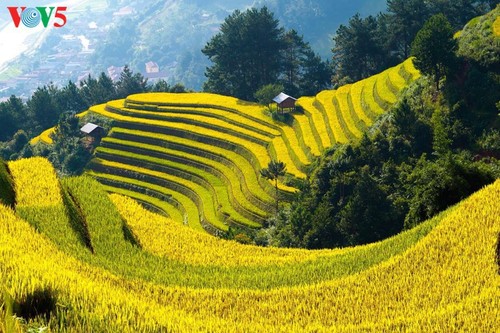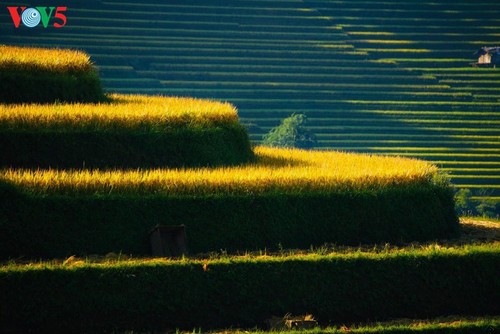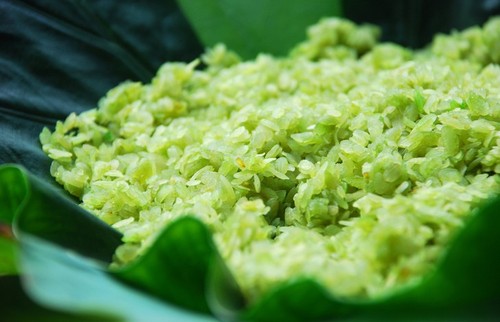A: Southern Vietnam is now at the start of the rainy season. The weather in the south is now cool with occasional showers. The temperatures range between 24 and 35 degrees Celsius.
B: Autumn is the best time of year to visit Hanoi being the most beautiful season, with a cool breeze, yellow sun, low humidity and temperatures between 19 and 32 degrees Celsius.
 Mu Cang Chai terraced field Mu Cang Chai terraced field |
A: At this time of year, visiting Vietnam’s northwest region, you encounter the stunning golden terraced rice fields. Mu Cang Chai district in Yen Bai province is famous for its breathtaking rice terraces. Its name comes up a lot at travel agencies at the end of September and early October, the time when the local rice fields are mature.
B: Mu Cang Chai in autumn exudes a sense of abundance as the terraced fields turn a rich gold color. The terraced rice fields look like golden silk scarves rippling in the wind across the green mountain slopes, making the mountainous landscape astonishingly beautiful.
A: Mu Cang Chai’s terraced rice fields and the distinctive culture of the local ethnic minority groups create a unique atmosphere. This explains why so many tourists are flocking there.
 Its imposing beauty makes Mu Cang Chai a destination in Autumn Its imposing beauty makes Mu Cang Chai a destination in Autumn |
B: We received a letter and a beautiful postcard of the Sebastian river from Richard Nowak of the US this week. Mr. Nowak, a regular listener of VOV, expressed his interest in our show of August 15 with a story about the preservation of President Ho Chi Minh’s embalmed body over the course of 50 years, and the implementation of the President’s testament, and voiced his appreciation of the Letter Box.
A: Thank you, Mr. Nowak, for your regular feedback on our programs and supporting shortwave.
B: We’d like to welcome Tim Watson of the US who listened to our broadcasts on August 26 and 31 on the frequency of 6405 khz and 7315 khz. He reported that the signal on 6405 khz was good but there was some noise and fading at times while the frequency of 7315 khz had an excellent signal, albeit with slight noise and some fading at times.
A: He wrote: “This was the first time I heard the Voice of Vietnam in quite a while and I was reminded of how much I missed it. I was able to identify it as being relayed by WHRI but I couldn’t find out much about the broadcast on 6405 khz. It doesn’t seem to be listed anywhere. I enjoyed the programming very much, especially the cultural insights.”
B: Thank you, Mr. Watson, for tuning in to VOV broadcasts. Currently our broadcast to the US is only on the 7315 kHz frequency to but we will check with the technical department to give you more information on the VOV broadcast you heard on the frequency of 6405 khz. Thank you for your feedback on our Sunday Show, which featured a story about ways to reduce the use of plastic bags. We will confirm it with a QSL card. We look forward to your further feedback in the future.
A: We’d like to welcome back Anders Brissman and Christer Carnegren of the DX Forbund club of Sweden. They both sent us reception reports for the broadcast from 19:05 to 19:21 on September 6 on the frequency of 7280 khz.
B: Thank you very much for tuning in to our English broadcast on the Voice of Vietnam. We’ll send you QSL cards to confirm your report and look forward to hearing more from you.
A: This week, many listeners told us that they want to know more about popular food during autumn in Hanoi, particularly Com or young green rice.
 Autumn is when young green rice is sold on every corner of Hanoi Autumn is when young green rice is sold on every corner of Hanoi |
B: Green young rice (Cốm) is a traditional dish that is made only in autumn and cherished by all Vietnamese people. For Hanoians, nothing evokes the feeling of autumn like the taste of green young rice. The product has been recognized as a national trademark and is one of Hanoi’s iconic specialties.
A: Vong and Me Tri are the two Hanoi villages famous for making green sticky rice. Green sticky rice can be made from several different types of paddy, but the most delicious is made from yellow flowery paddies.
B: Green sticky rice is often eaten by hand, directly from the lotus leaves, a pinch at a time. When eating green sticky rice, you must savor it and chew very deliberately in order to appreciate the scent, texture, and taste of the young rice, which is sweet, nutty and buttery.
A: Besides “instant consumption”, young rice can be used in different dishes, including main courses, desserts and snacks. Stirred fried green rice, green rice cakes, and green rice sausages are three exotic “made from Cốm”’ dishes for tourists, perusing the Hanoi streets in autumn.
B: This week, in a reception report for the program on September 21 on the frequency of 7220 khz, Siddhartha Bhattacharjee asked whether circus performances in Vietnam still use animals.
A: Circus performances using wild animals at Dam Sen theme park in Ho Chi Minh City were discontinued last year following a request by the Asia for Animal Coalition (AfA).
B: Animals such as bears and orangutans, which were mentioned in the AfA petition are no longer used in circus performances.
A: Ta Duy Anh, director of the Vietnam Circus Federation said the circus industry in Vietnam began in 1922 with several animals such as tigers and horses. According to Anh circus fairs and competitions in France, Italy, China and Russia still include animal performances.
B: Around the globe, there are two opinions on this issue. Some people say we must protect animals and return them to nature. Others say we need only provide animals with more natural habitats.
A: In Vietnam, animal cages are clean and the food is fresh. They have carers and veterinarians give them periodic vaccinations. Old elephants that have performed for over 30 years are released into the wild. The Vietnam Circus Federation is planning to switch from wild animals to more domesticated ones such as chickens, pigs and dogs. The wild animals will be transferred to the Thu Le Zoo in Hanoi.
A: This week we acknowledge reports from Roger Roussel of Canada, Hayato Furukawa of Japan, Saif Khan, Khadija Sultana, Mosrur Zunaid, Abdur Razzak, and Mizanur Rahman of Bangladesh, and Jayanta Chakrabarty and Deep Paul of India.
A: We’d like to thank you all for sending feedback on our shortwave broadcasts and internet content. We’ll send you verification cards to confirm your reports.
B: We welcome your feedback at: English Service, VOVworld, the Voice of Vietnam, 45 Ba Trieu street, Hanoi, Vietnam. Or you can email us at englishsection@vov.org.vn. You’re invited to visit us online at vovworld.vn, where you can hear both live and recorded programs. Check out our VOV Media App available on both the IOS and Android platform to hear our live broadcasts. We look forward to your feedback on the mobile version of vovworld.vn. Once again, thank you all for listening. Goodbye until next time.